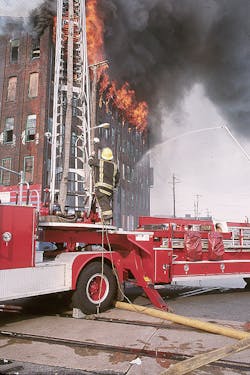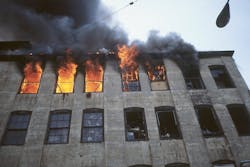Fire Studies: Defensive and Transitional Modes of Fire Attack
As a battalion chief at one particularly difficult fire, I found the top floor of a three-story multiple-occupancy dwelling well-involved on arrival. The first-in company officer ordered all companies to operate with 1¾-inch hoselines. I believed that the call was correct and checked with the captain of the first-due truck company to brief me on interior conditions. He reported that the engine company just arrived at the base of the third-floor steps with charged hoselines, and they were starting their advance to the third floor.
A few minutes passed, and seeing no appreciable difference from the exterior, I again contacted the truck captain. He reported that they were making no progress and that conditions had worsened. The fire now was starting to drop down onto them. At that point, I ordered the companies out from the building for an exterior attack and directed all incoming companies to operate with large-diameter hoseline and to utilize master streams. The strategy paid off. Within a short time of the evacuation, the roof and a sidewall of the structure collapsed.
Although the initial orders for an offensive attack were correct in my estimation, continuing size-up, additional information (interior assessment) and changing fireground conditions necessitated the change to a defensive mode.
Defensive mode
Exterior or defensive operations should be initiated when:
- A fire is beyond the control of handheld hoselines
- There are heavy fire conditions and no civilians are in the fire building, or the amount and location of the fire precludes that any people who are inside still are alive
- Insufficient resources are on scene
- There is an insufficient water supply
- The fire involves lightweight structural components
- The risk to firefighters outweighs the gain
The first-arriving officer’s observations and ensuing orders are critical. This person must evaluate conditions in relation to resources that are on scene. Can the personnel who are present adequately protect exposures while mounting an attack on the initial fire building? Should the initial forces be deployed to concentrate on protecting exposures and later-arriving units be utilized to attack the main body of fire?
When a strictly defensive operation is apparent, the first-responding officer must make a reasonable assumption of what the fire will consume and where it can be stopped. The incident commander (IC) must be prepared to write off parts of buildings or even entire buildings if they are past the capability of a department to save them. Failure to give up a building that already is lost and concentrating resources on it result in chasing a fire. This objective usually sets up a losing situation. On the other hand, making realistic goals on what can be saved and where the fire can be stopped minimizes losses.
Exposures
The fire can spread within the original fire building and to nearby structures. This spread of fire is dependent on:
- Amount of heat that’s generated by the fire (what is burning?)
- Distance or spacing between buildings (the greater the distance between the buildings, the better the capability of the department to protect them; adjoining or interconnected buildings can present severe exposure problems)
- Duration of the fire
- Wind conditions (high winds can fan a fire and cause it to spread)
- Flying brands that are created by the fire
- Height of the buildings (taller buildings that are exposed to lower buildings can have multiple floors at risk)
- Construction of the fire building and the exposed buildings (frame buildings are more susceptible as an exposure threat than a fire-resistive building)
- Active fire protective systems in the exposures (standpipes, sprinklers, exterior deluge sprinkler systems, which are designed to protect from extension of fire to exposed buildings)
- Passive fire protective systems in exposures (e.g., wired glass)
- Fire department actions and intervention
Protecting exposures
Controlling a fire and protecting exposures depend on some of the same factors. On arrival of the initial units, decisions must be made regarding:
- Where the fire is located and what is the path and speed that a fire is traveling
- The extent and type(s) of fuel that’s burning
- The proximity of the exposed buildings and their contents
- The likely spread of fire and what other buildings are threatened
- The exposures that already are involved in fire
- How is protecting exposures prioritized, and what is the best method of protecting them? (Master streams? An interior attack in the exposed buildings?)
- The available water supply
- The resources that are on scene
- The resources that are responding and their capabilities
- What orders should be given to the incoming companies?
- How long will it take for hoselines to flow water?
- What additional resources should be called?
- The best way of organizing the scene
Often these decisions must be made under severe time constraints. They can be difficult considerations, and the decision-maker must rely on personal experience. This knowledge can be based on a similar incident that the individual experienced or on training sessions where large-scale events were practiced in simulations.
Once assessments are made, needed resources should be called. It is better to request a sufficient amount of apparatus, personnel and equipment and then utilize staging to keep them in reserve should the anticipated problems develop. If the projected problems don’t materialize, those additional resources can be used to relieve units that are on scene, or they can be returned to their stations.Transitional modes
Transitional modes of fire attack consist of a combination of offensive and defensive attacks. For example, there’s the offensive/defensive mode. Consider this: On arrival, heavy fire conditions in a residential structure might be a specific cue for a defensive attack. However, although a fire might have control of the better part of the building, a report of people trapped within the building still might allow an initial interior attack. The initial IC can have the first-arriving units go into an offensive-interior attack mode, utilizing handheld hoselines to protect the search and rescue crews, knowing that a defensive attack will be necessary after rescues have been made.
An offensive/defensive attack also might be required when fireground conditions dictate a need to change from an offensive to a defensive mode. This can occur because of increased fire conditions, structural failure, multiple collapse indicators, interior reports of lack of progress, etc.
Your goal is to predict and be prepared for changes prior to their occurrence, but this isn’t possible all of the time. Incident scenes can be ever-changing events, and as changes occur, you must be prepared to adapt to the situation. If withdrawal from a building is necessary during an offensive attack, the officer who gives the order should stipulate whether it is an immediate and emergency withdrawal that necessitates the abandonment of the hoseline or whether the hoseline will be backed out of the building.
A defensive/offensive attack can be used when the amount of fire is beyond the control of handheld hoselines or when resources that are on scene are insufficient to mount an offensive interior attack. If the fire is beyond the capability of handlines to control, master streams can be utilized to knock down the fire in a blitz attack. After knockdown, the building can be checked for structural stability and, if sound, an offensive-interior attack can commence.
If the defensive attack was initiated because of insufficient staffing on scene or awaiting water tenders to arrive, the IC can deploy hoselines to start knocking down the fire from the exterior until the arrival of sufficient resources. Upon their arrival, the IC can switch to an offensive interior attack.Evaluating the incident scene
As higher-ranking officers arrive on scene, their assessment of the incident must consider whether to:
- Continue the strategies and tactics that are in place
- Modify the strategies and tactics as required to reach the desired goals
- Change the mode of fire attack to address the conditions that were found on their arrival
Realize that ever-changing fireground conditions must be considered and decisions must be made accordingly, including to withdraw everyone from the structure. The withdrawal of interior streams and the setup of a defensive attack is one of the most difficult jobs of command. This is particularly true when the initial IC’s actions were correct at the time of arrival but, because of changing conditions, no longer are feasible.
Recognize that it doesn’t mean that you were wrong when you made the decision to withdraw from the structure but the collapse or accelerated fire conditions that you anticipated didn’t occur. Decisions must be made based on what might happen and the disastrous results that could occur if firefighters remain in the structure.
Remember, too, that the companies that operate on the interior might not have the big picture or all of the information that’s available to the IC. Most aggressive firefighters believe that, if left alone, they can put out any fire. The safety of personnel always must be a prime consideration.
Changing attack modes
There must be clear direction from the IC when an attack mode is changed to a defensive attack. All units must acknowledge the order to change the attack and immediately start initiating the change. Interior and exterior operations rarely are compatible. Exterior streams must not be directed into windows or doors while firefighters operate in the building unless fully coordinated by the IC and crews who operate on the interior. When going from an offensive to a defensive mode, there is a tendency to continue operating handheld hoselines that were withdrawn to the exterior, alongside master streams. This should be allowed only to protect exposed areas until master stream devices can be placed: A defensive attack should be performed with master stream devices.
Operating in a defensive or transitional mode requires constant evaluation of conditions. Because firegrounds are dynamic events, as conditions change, we must change. ICs must avail themselves of whatever information is available when making fireground decisions. The responsibility of changing strategies directly affects firefighter safety and incident stabilization.

James P. Smith
JAMES P. SMITH, who is a Firehouse contributing editor, is a retired deputy chief of the Philadelphia Fire Department. He is an adjunct instructor at the National Fire Academy and the author of the fourth edition of the book "Strategic and Tactical Considerations on the Fireground," which was published by Brady/Pearson.








